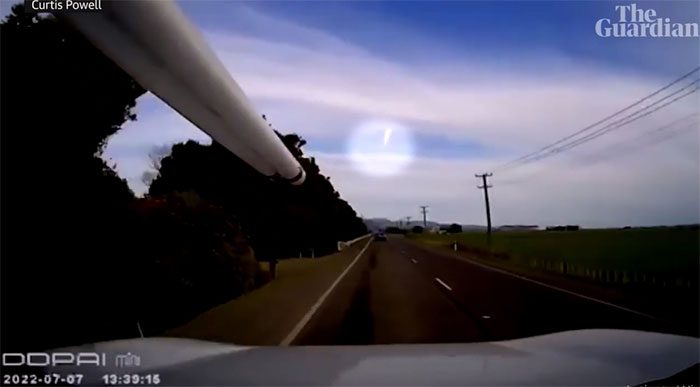Many residents on the North Island heard a rumble and saw a streak of light streak across the sky on July 7 (local time).
Video: Curtis Powell
Scientists believe that the sound and light streak witnessed by the public on the afternoon of July 7 likely originated from a meteorite. Seismologists at Geonet detected signals that could be sound waves from the object, while scientists at New Zealand’s Met Service also believe they recorded this object or its smoke trail on radar.
Plumber Curtis Powell’s dash cam captured the streak of light racing across the sky while he was driving north of the town of Shannon, North Island, at 1:39 PM. “We were driving to work in Shannon when we saw a blue streak coming down from the sky, followed by a large flash of light,” he recalled.
Many people initially thought the rumbling sound was caused by an earthquake. “We thought it was an earthquake, but that didn’t seem quite right. The sound was like a very large heavy truck passing by, but there were no trucks near our house at that time. The house also shook slightly,” a user shared on social media platform Twitter.

The dash cam captures the moment the streak of light descends in the sky over New Zealand.
Dr. Duncan Steel, a space scientist who has worked for NASA, believes that the unidentified object is likely a fragment of a meteorite, and seeing a meteorite in daylight is very rare. “In my lifetime, I have only seen a meteorite in daylight once. They enter the atmosphere very quickly, typically around 30 km per second. To be visible during daylight, they must be quite large, equivalent to a rugby ball or larger. This makes them very rare,” he explained.
Some witnesses reported hearing a crackling sound as the object moved across the sky. Steel noted that this could be electrophonic sound. Meteorites and their accompanying electrical charges can cause some people’s hair to stand on end, according to expert Allan Gilmore at the Mt. John Observatory of Canterbury University. “People with frizzy hair often hear it, while others do not,” Gilmore said.
Dr. Ian Griffin, director of the Otago Museum, urged the public to keep any videos and photos. “We can use them to determine the object’s location as well as where it landed – if at all. Recovering it could be scientifically significant. Meteorites are quite rare in New Zealand, so it would be fantastic to retrieve a piece,” he said.





















































